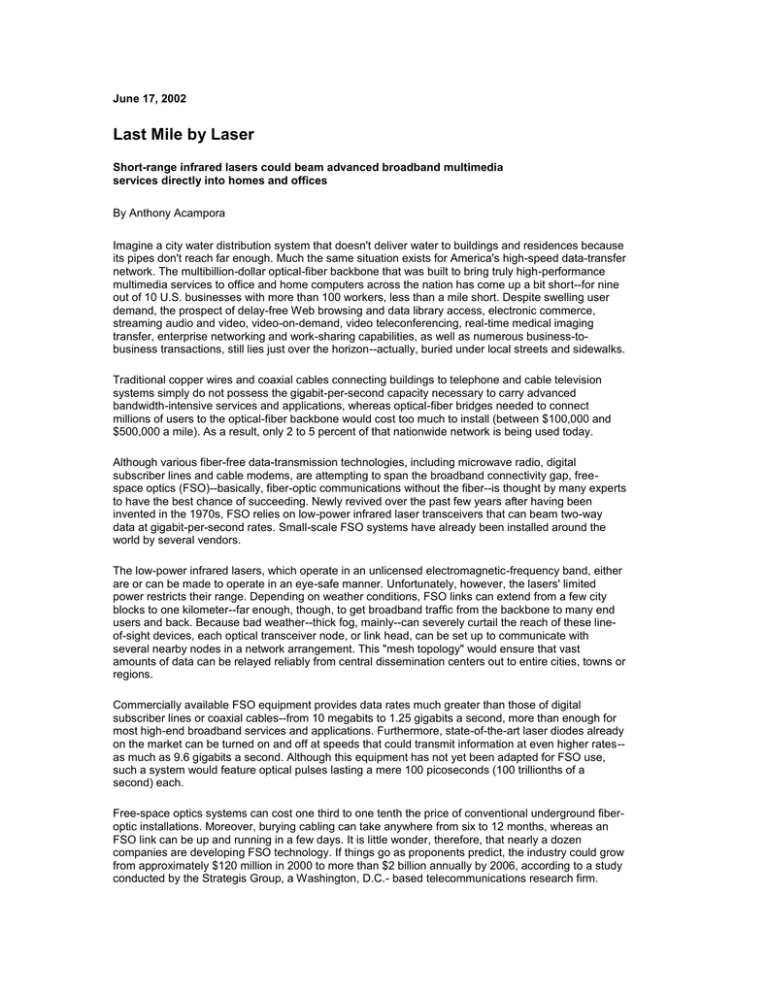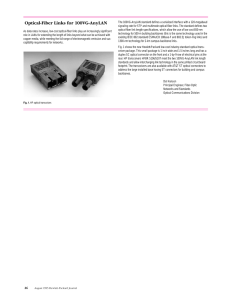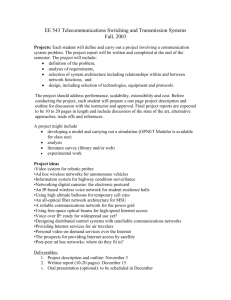
June 17, 2002
Last Mile by Laser
Short-range infrared lasers could beam advanced broadband multimedia
services directly into homes and offices
By Anthony Acampora
Imagine a city water distribution system that doesn't deliver water to buildings and residences because
its pipes don't reach far enough. Much the same situation exists for America's high-speed data-transfer
network. The multibillion-dollar optical-fiber backbone that was built to bring truly high-performance
multimedia services to office and home computers across the nation has come up a bit short--for nine
out of 10 U.S. businesses with more than 100 workers, less than a mile short. Despite swelling user
demand, the prospect of delay-free Web browsing and data library access, electronic commerce,
streaming audio and video, video-on-demand, video teleconferencing, real-time medical imaging
transfer, enterprise networking and work-sharing capabilities, as well as numerous business-tobusiness transactions, still lies just over the horizon--actually, buried under local streets and sidewalks.
Traditional copper wires and coaxial cables connecting buildings to telephone and cable television
systems simply do not possess the gigabit-per-second capacity necessary to carry advanced
bandwidth-intensive services and applications, whereas optical-fiber bridges needed to connect
millions of users to the optical-fiber backbone would cost too much to install (between $100,000 and
$500,000 a mile). As a result, only 2 to 5 percent of that nationwide network is being used today.
Although various fiber-free data-transmission technologies, including microwave radio, digital
subscriber lines and cable modems, are attempting to span the broadband connectivity gap, freespace optics (FSO)--basically, fiber-optic communications without the fiber--is thought by many experts
to have the best chance of succeeding. Newly revived over the past few years after having been
invented in the 1970s, FSO relies on low-power infrared laser transceivers that can beam two-way
data at gigabit-per-second rates. Small-scale FSO systems have already been installed around the
world by several vendors.
The low-power infrared lasers, which operate in an unlicensed electromagnetic-frequency band, either
are or can be made to operate in an eye-safe manner. Unfortunately, however, the lasers' limited
power restricts their range. Depending on weather conditions, FSO links can extend from a few city
blocks to one kilometer--far enough, though, to get broadband traffic from the backbone to many end
users and back. Because bad weather--thick fog, mainly--can severely curtail the reach of these lineof-sight devices, each optical transceiver node, or link head, can be set up to communicate with
several nearby nodes in a network arrangement. This "mesh topology" would ensure that vast
amounts of data can be relayed reliably from central dissemination centers out to entire cities, towns or
regions.
Commercially available FSO equipment provides data rates much greater than those of digital
subscriber lines or coaxial cables--from 10 megabits to 1.25 gigabits a second, more than enough for
most high-end broadband services and applications. Furthermore, state-of-the-art laser diodes already
on the market can be turned on and off at speeds that could transmit information at even higher rates-as much as 9.6 gigabits a second. Although this equipment has not yet been adapted for FSO use,
such a system would feature optical pulses lasting a mere 100 picoseconds (100 trillionths of a
second) each.
Free-space optics systems can cost one third to one tenth the price of conventional underground fiberoptic installations. Moreover, burying cabling can take anywhere from six to 12 months, whereas an
FSO link can be up and running in a few days. It is little wonder, therefore, that nearly a dozen
companies are developing FSO technology. If things go as proponents predict, the industry could grow
from approximately $120 million in 2000 to more than $2 billion annually by 2006, according to a study
conducted by the Strategis Group, a Washington, D.C.- based telecommunications research firm.
Bridging the Last Mile
Free-space optics uses apparatus and techniques originally created for optical-fiber cable systems, the
very technology it is meant to supplement. Digital information in the form of electronic signals (the 1's
and 0's that make up binary computer codes) is sent through a roof- or window-mounted infrared laser
diode transmitter that converts each logical 1 into a narrow pulse of optical energy. When the system is
operational, the absence of such an invisible pulse represents a logical 0. The process of modulating
data into a digital optical signal is known as on/off signaling, or keying. Transmission efficiency is
enhanced by packetizing data--splitting traffic into independent packets that can be individually
addressed and sent. In addition, FSO can support wavelength division multiplexing (WDM), a
technique that allows a single optical path to carry tens of separate signal channels, as long as each is
encoded in a slightly different wavelength.
After being emitted by the 850- or 1,550-nanometer laser diode, the optical pulses are focused by a
lens and sent out as a collimated beam of light, like that generated by a flashlight. Despite focusing by
the lens, the power of the beam disperses with distance. When some of the transmitted light strikes the
aperture lens of a receiver (located on a roof or in a window), the collected optical power is focused
onto a photodetector, which converts the pulses into a weak electrical signal. A sensitive electronic
receiver next amplifies and regenerates the weak signal, completing the data-transfer link.
Although the transmitted infrared beam is narrow, it does diverge, forming a cone with a fairly large
breadth by the time it arrives at the receiving link head. The degree of beam spreading is determined
by the size of the transmitting lens, varying inversely with lens diameter. As a result, the amount of
energy actually striking the collecting lens falls off rapidly with distance (received energy varies
inversely with the square of the distance). For any given data rate, transmitted optical power, optical
receiver sensitivity and size of the receiving lens, this beam divergence imposes a maximum range
over which the optical link can operate.
To increase this link distance, larger-diameter transmitting
lenses must be used, thereby reducing beam spread and
Free-space optics systems can cost causing more optical power to strike the receiving lens. As the
beam is narrowed, however, minute targeting variations
one third to one tenth the price of
produced by building sway and the thermal expansion and
conventional underground fiber-optic
installations.
contraction of construction materials make it necessary to
introduce auto-tracking capabilities at both ends. This
requirement adds complexity and cost. Active tracking systems
use movable mechanical platforms or articulated mirrors to point
the pencil beam at the receiving lenses and to keep the receiving aperture pointed at the transmitter.
Feedback controls provide regular adjustments to keep the transmitter and receiver on target.
Lost in a Fog
Susceptibility to fog has slowed the commercial deployment of free-space optical systems. It turns out
that fog (and, to a much lesser degree, rain and snow) considerably limits the maximum range of an
FSO link. Fog causes significant loss of received optical power. This optical attenuation factor scales
exponentially with distance. In moderately dense fog, for example, the optical signal might lose 90
percent of its strength every 50 meters. This means that 99 percent of the energy is expended over a
span of 100 meters and that 99.9 percent is dissipated after traveling 150 meters. Thus, to be
practical, a free-space optical link must be designed with some specified "link margin," an excess of
optical power that can be engaged to overcome foggy conditions when required.
For a given link margin, it becomes meaningful to speak of another metric--the link availability, which is
the fraction of the total operating time that the link fails as a result of fog or other physical interruption.
Link-availability objectives vary with the application. When FSO technology is used for privateenterprise networking (for instance, to connect two offices of the same company situated in separate
buildings), 99.9 percent uptime may be acceptable. This value corresponds to a downtime of about
nine hours a year.
In contrast, public carrier-class service, which is provided to a carrier's prime business customers,
demands a link availability of 99.999 percent (in the telecommunications business, the so-called fivenines benchmark), which translates into only five minutes of allowable downtime a year. Fiber-optic
systems regularly operate at the five-nines service level. It is noteworthy that a key potential
application for FSO, cellular backhaul--transmission systems that connect cellular-radio base stations
with mobile switches connected to the public switched-telephone network--requires an operational
availability somewhere in between, around 99.99 percent.
Achieving this high level of performance is a challenge for free-space optics. The greater the density of
the fog, the greater the attenuation, the poorer the availability and the shorter the allowable range. In
regions where dense fog occurs rarely, excellent link availability may be achieved at a range
approaching the maximum allowable, approximately one kilometer. In less favorable climates,
however, this distance would be far less.
To solve the range/reliability problem, FSO systems can be designed with limited link lengths as part of
an interconnected optical mesh topology, a spiderweb-like arrangement that extends broadband
service to many buildings that would otherwise be too distant from the fiber-optic backbone to be
reached by a single FSO link. In a mesh network, the building located closest to the optical-fiber
terminus is equipped with an FSO "root" node that attaches to the fiber and contains several optical
transceivers. Other served buildings are also equipped with FSO nodes with multiple transceivers.
These transceivers allow the nodes to communicate with nearby neighbors in an interconnected mesh
arrangement.
Signals intended for a particular building are sent from the root node down a particular set of mesh
links, with intermediate nodes serving as regenerative repeaters along the way. Similarly, signals are
sent from a given building to the root node along another route. Thus, the length of each optical link is
kept sufficiently short to achieve high immunity to fog. Should a link fail, signals would be redirected
along an alternative pathway, making use of redundant routes, thereby facilitating rapid recovery from
equipment failures. Finally, a mesh can be connected to several root nodes, thereby providing greater
overall capacity to the collection of served buildings.
In addition to requiring a few optical transceivers, each
regenerator/repeater station in a mesh system must contain an
electronic switch to combine the signal traffic (multiplexing) from The optical mesh extends
the local building with that beamed from other nearby buildings
broadband service to many buildings
and to route signals between the root node and each served
that would otherwise be too distant to
be reached by a single free-space
building. Furthermore, the necessary multiplexing,
demultiplexing and switching functions mean that all the signals optical link.
from all the users' diverse computing and communications
equipment must be converted into a common format. This signal
format conversion is accomplished by a device called a network
termination unit. Although data can be passed through many nodes along various paths, it appears to
users as if each signal has been delivered to the fiber backbone by means of its own dedicated
transmission line. Fiberlike bandwidth can therefore be provided over wide areas, and new nodes can
be installed relatively quickly and easily to bring buildings "on-net."
For each signal from each building, the network management software chooses a pathway through the
mesh that passes through one of the system's root nodes. Because node failure can be sensed by the
software, affected signals can be instantly directed around the problem. By reserving some
unallocated capacity on each optical link, the network designer can ensure that there is sufficient
capacity to reroute and recover from single- or multiple-link failures that might occur.
Competing with free-space optics to unclog the last-mile bottleneck is point-to-point microwave radio, a
technology that is immune to fog attenuation. On the negative side, licenses are needed to operate in
most microwave radio bands, and the spectrum available in most bands is limited, which means that
capacity is restricted. Microwave radio is also more costly than FSO systems and may be susceptible
to transmission interference. Further, microwave radio is subject to significant signal attenuation in
heavy rain, especially at higher frequencies where more spectrum might be available.
If microwave radio were operated at a frequency of 60 gigahertz, however, it could complement freespace optics. The U.S. Federal Communications Commission has allocated some unlicensed
spectrum at 60 GHz for high-speed applications. The greater spectrum allocation at 60 GHz implies
that more capacity can be provided and a less spectrally efficient (hence, lower-cost) modulation
scheme might be used, such as simple on/off signaling. Because severe rain (which might cause a
radio link failure) and dense fog (which might cause an FSO link failure) do not exist simultaneously,
the opportunity exists to boost network reliability by combining 60-GHz radio with FSO. Linking the two
technologies would mean that the resulting system could be highly reliable over significantly greater
distances.
Although free-space optics has some distance to go in addressing its remaining concerns, it's still the
best bet to reach across the last mile and bring about the long-awaited broadband revolution.
© 1996-2003 Scientific American, Inc. All rights reserved.
Reproduction in whole or in part without permission is prohibited.



